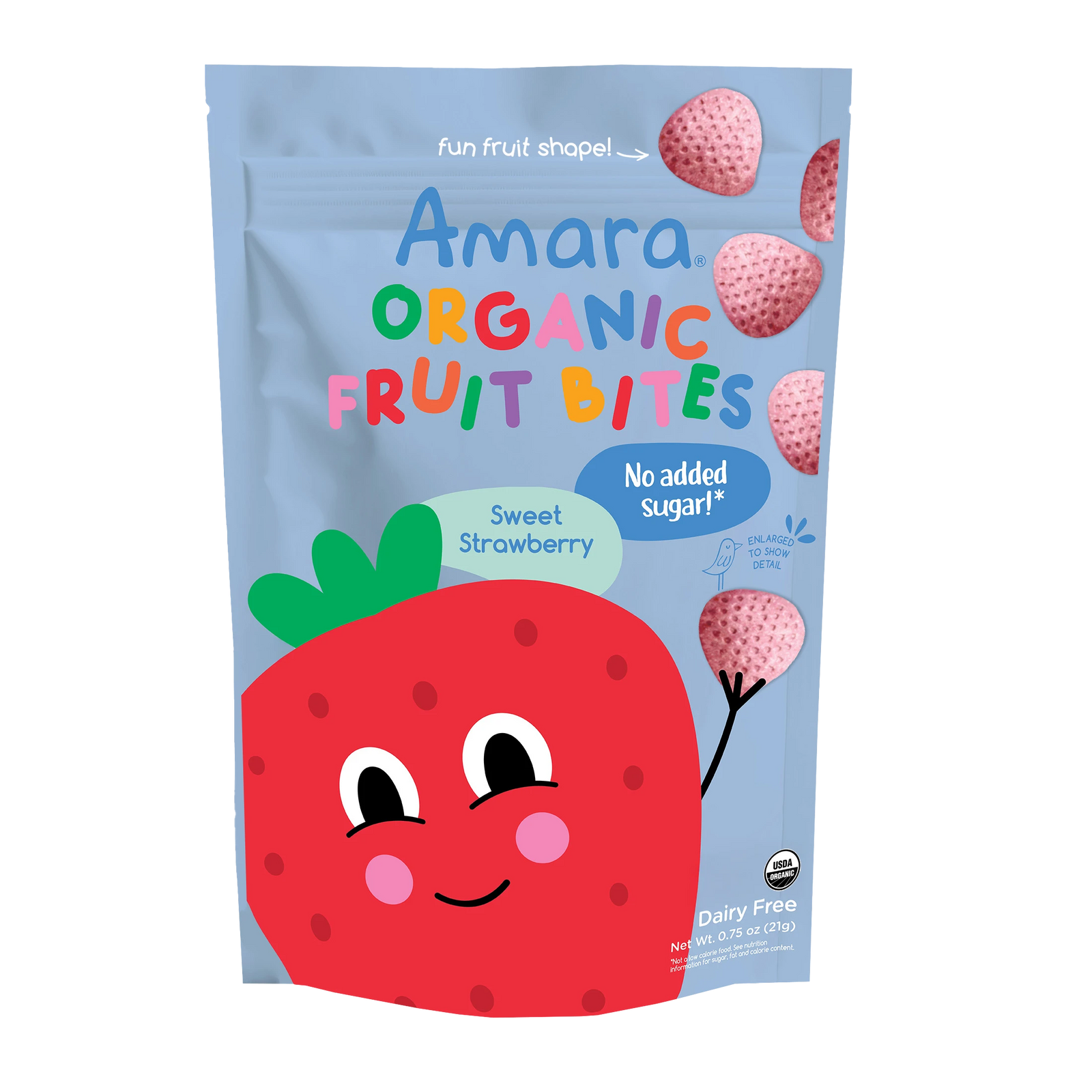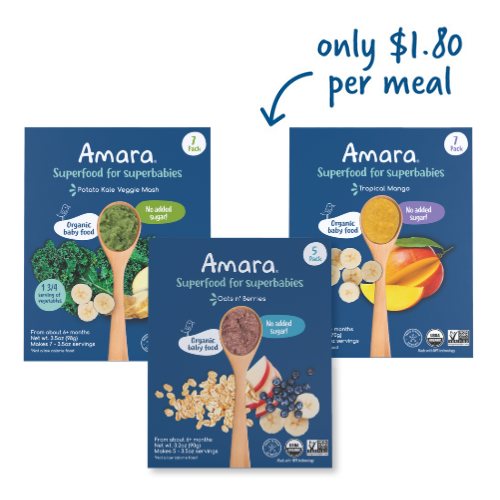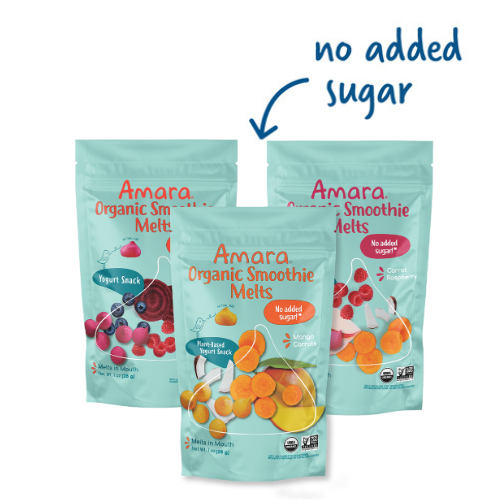An Overview:
. It’s important to recognize that babies have an innate preference for sweet tastes, but the key is not to reinforce that preference and to expose them to a variety of different flavors and food textures. (https://www.rcpch.ac.uk/news-events/news/tougher-baby-food-regulations-needed-improve-child-health-say-experts)
. Avoid any baby food withadded sugar. Neither your infant nor your childrennor yourselfneed to consume refined sugar. It is a habit and a pleasure, but from the nutritional side, your child does not need it, and excess sugar can do harm. It only provides energy with no other nutrient.
. Seek out natural baby foods with ingredients you understand and recognize. Avoid only offering baby sweet-tasting foods during weaning. Babies are open to new tastes. Babies can and will learn to tolerate, and even enjoy, a variety of tastes if given the opportunity, like bitter, sour, umami, the whole spectrum of natural tastes. Sometimes they need to repeat the taste several times to get used to it, but don’t give up. To get started, try our Introduction to Vegetables Variety Pack to start your baby on a journey to a lifelong of healthy food choices.
. Cereals are often the first solid food given to infants. Look for whole grain cereals without any additives. They can be mixed with some fresh fruit, but avoid sweetened cereals with any added sugar (like sucrose, fructose, high fructose corn syrup) or any other sweetener.
. Yogurt, like cow’s milk, is not recommended for infants under 12 month of age. During the first year of life, breast milk or formula is recommended. However, when your child is old enough to begin to enjoy yogurt, choose plain yogurt and add your own fresh fruit. Avoid sweetened yogurt or fruit-flavored yogurt.
. Avoid any sweetened beverage for your baby, like fruit juice and sweetened teas, etc.
. Nutrition and dietary habits during infancy and into early childhood play a role in shaping eating habits and health later in adolescence and into adulthood.
When your toddler is ready for finger foods, choose snacks without any added sugar. Some possibilities are fresh, ripe, soft (cooked) pieces of fruits and vegetables, as well as soft wholegrain bread, or our Organic Yogurt Smoothie Melts with no sugar added.
Trust Amara to deliver you baby food just like homemade, but easier.
The Details and Research:
We know babies are constantly learning, observing, and absorbing what is around them. We can clearly see physical milestones our babies reach. What babies are also learning during these formative months that is not as easy to see are their food preferences and dietary patterns. In fact, researchers have found that newborn babies have an inborn preference for sweet tastes. This is most likely a biological adaptation to readily accept breast milk, which has a sucrose density higher than both goat and cow milk. In short, breast milk is quite sweet. The preference for sweetness is deepened with the association between mother’s milk and close maternal contact, warmth, and security during feedings, so it is only natural babies find it pleasurable.
This early introduction to sugary tastes is continued with the starting of solids. “The recent review of NHANES examining infant feeding over 2 different time periods (2005–2008 and 2009–2012) shows that the most commonly offered items were sweet tasting: infant cereals (25.9%), fruits (13.6%), and 100% fruit juice. ”Of note, in 2005, the AAP changed its recommendations to exclude fruit juice from 6-12 month old’s diet. While historical juice was recommended for some of its health benefits, such as vitamin C, experts now see the negatives outweigh the positives. Juice can reinforce an already developed preference for sugar. It can lead to unnecessary weight gain, tooth decay, and replace more nutrient-dense foods. It can also lead to drinking sugary beverages, such as soda, in adolescence, so it is best avoided completely.
Aside from a fast dose of energy, sugar is a non-nutritive source of calories, meaning it offers nothing to our babies (and ourselves) in terms of nutrition. White sugar is found nowhere in nature. It is a product of industrialization and has a powerful effect on both our bodies and minds. Still, studies have shown that up to 60% of infants are introduced to foods and beverages containing added sugars, a major threat to diet quality.
As infants are introduced to solid foods during weaning, they may be exposed to additional processed food products that contain added sugars. Like some formulas, solid foods may contain sucrose and other sugars that are not present in breastmilk. Commercial baby foods and other common grocery items that children are often exposed to in infancy can be a source of added sugars, which contribute to total daily sugar exposure.
First foods, such as apples, can reach sugar levels over 85%. This is normal for apple puree, whether it is made at home without adding sugar or bought. That is why fruit purees should be given to infants in moderation, as a part of a balanced diet, and not exclusively given fruit. Fruit is recommended and healthy, but it should be accompanied with whole grains and vegetables. Further, fruit purees should be offered with a spoon, developing a baby’s feeding skills, and slowing down the eating process allowing for signs of fullness to develop. When babies and toddlers consume purees from pouches, they slurp the puree quickly and swallow, leading to faster consumption.
Many packaged foods, including baby food and toddler snacks, have either added sugar, or they are very high in fruit sugars. In fact, “A recent analysis of 240 of the most popular baby and toddler foods in the US showed that 100 percent of baby food desserts, 92 percent of fruit snacks, 86 percent of cereal bars and 57 percent of teething biscuits and cookies contained more than 20 percent of their calories from sugar. Almost 40 percent of all products listed sugar (or some form of sugar) as the first or second ingredient, even those branded as healthy choices.” These companies understand babies’ innate preference for sugar and know its addictive effects.
But wait? My pouch only lists fruits and vegetables. That can’t mean it is high in sugar, right? Unfortunately, no. Many baby foods indicating no added sugar in their ingredients have high sugar content. This is possibly due to the presence of other sugar sources (brown rice syrup, evaporated cane juice, mono- and diglycerides, invert sugar and fruit or fruit juice concentrate) that are not generally highlighted as sources of added sugar. Thus, in many products listing no added sugar there are still high levels of fructose and sucrose regardless of whether the source of the sugar is added or naturally-occuring, which is similar to recent findings in fruit juices. Furthermore, process can increase natural sugars. For example, conventional pouches are filled with fruit purees which have been cooked and treated repeatedly with high heat. This essentially concentrates the fruit’s natural sugars, like boiling a fresh apple into applesauce, and also breaks down beneficial parts of the fruits which help control blood sugar, such as fiber. So actually comparing sugar grams along with the ingredient list can offer a clearer picture of a food’s sugar load.
What does all of this mean for me and my baby? The negative effects of too much sugar in our children’s diets is becoming more and more of a worldwide health issue. To learn more about the health implications of sugar and children, check out our blog post “Harmful Effects of Sugar on Babies and Toddlers.”
Preparing food at home is the best way to control the amount of added sugar in your baby and toddler’s diet. However, when making food from scratch isn’t possible, you can trust Amara to deliver all of the benefits of fresh, homemade baby food and snacks without any of the added junk- or hassle. Explore our 100% organic, veggie-forward baby food and snacks HERE.


Don't take our word for it, see what hundreds of happy moms are saying about Amara.
 Amara's Chief Nutritionist: Sonia A. Schiess, PhD in Nutrition, specialized in the introduction of solids and liquids to infants. Sonia's passion started when she was studying nutrition and dietetics in university, completing a post degree in Human Nutrition. Later on, she completed her PhD as a nutritionist, with a focus on introducing food in the first year of a baby's life. Her wide experience gives her a unique perspective, drawing from her time in clinics, hospitals, independent consulting and university research. She's authored several papers including "Introduction of complementary feeding"; "Introduction of potentially allergenic foods in the infant's diet during the first year of life" and "Intake of energy providing liquids during the first year of life" in five European countries. The combination of Sonia's science and our chef's magic ensures every Amara product is not only optimized for your baby's health but is delicious as well.
Amara's Chief Nutritionist: Sonia A. Schiess, PhD in Nutrition, specialized in the introduction of solids and liquids to infants. Sonia's passion started when she was studying nutrition and dietetics in university, completing a post degree in Human Nutrition. Later on, she completed her PhD as a nutritionist, with a focus on introducing food in the first year of a baby's life. Her wide experience gives her a unique perspective, drawing from her time in clinics, hospitals, independent consulting and university research. She's authored several papers including "Introduction of complementary feeding"; "Introduction of potentially allergenic foods in the infant's diet during the first year of life" and "Intake of energy providing liquids during the first year of life" in five European countries. The combination of Sonia's science and our chef's magic ensures every Amara product is not only optimized for your baby's health but is delicious as well.
References:
Editorial, The Lancet, Diabetes-Endocrinology, 2019
S Ghosh et al., High sugar content in baby food: an Indian perspective, The Lancet, Diabetes-Endocrinology, 2019
MI Goran et al., Effects of consuming sugars and alternative sweeteners during pregnancy on maternal and child health: evidence for a secondhand sugar effect. Proc Nutr Soc 2019
MB Heyman et al., Fruit juices in infants, children, and adolescents: current recommendations, 2017
NC Marais et al., Evidence for high sugar content of baby foods in South Africa, S Afr Med J 2019
RD Murray, Savoring sweet: sugars in infant and toddler feeding, Ann Nutr Metab 2017
RW Walker & MI Goran, Laboratory determined sugar content and composition of commercial infant formulas , baby foods and common grocery items targeted to children.









Leave A Comment